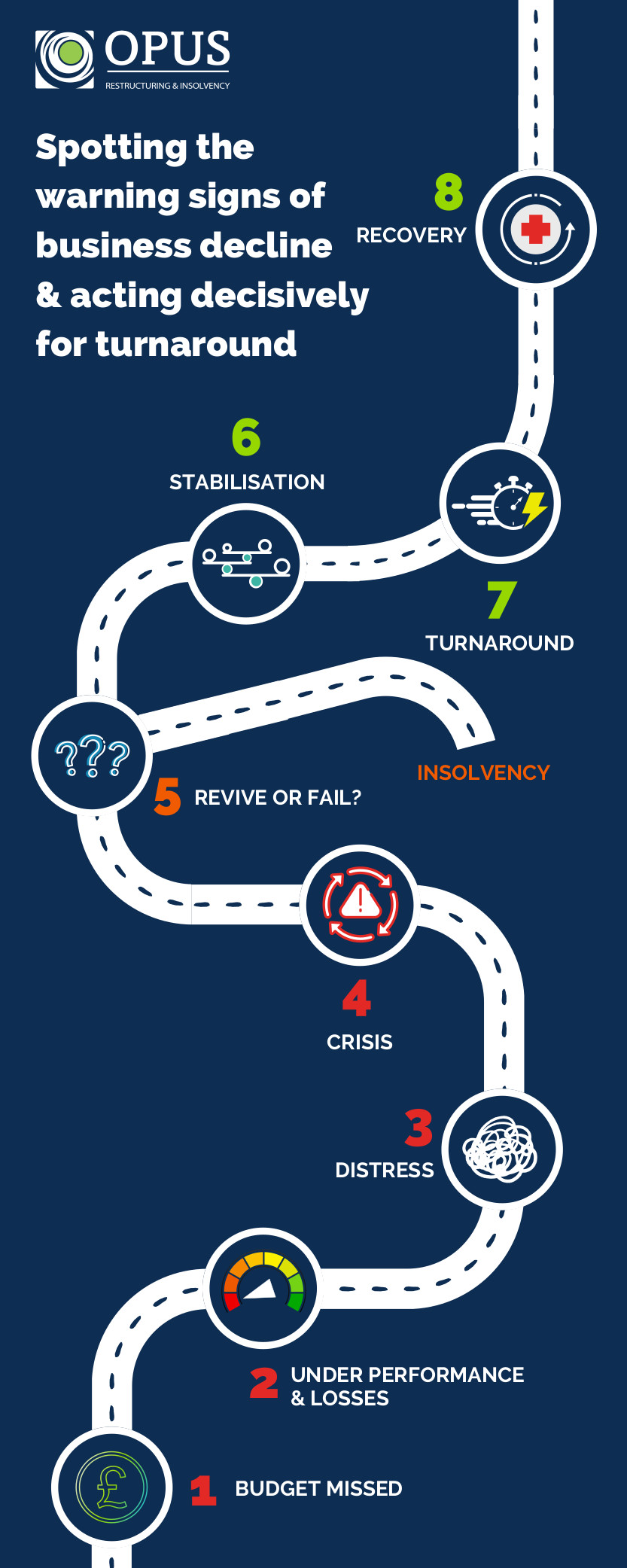All businesses go through phases and cycles: from formation to growth to plateauing and, in some cases, on into decline and beyond. Good management sees the red flags early and takes corrective action before the downturn sets in and becomes irreversible. Here, we outline the critical warning signs and the process of recovery, which is outlined in this diagram.
Budget missed
Budgets and forecasts are always wrong, the only question is by how much and in which direction. The skill is in understanding why and how significant a shortfall in any key area is going to be and then taking the appropriate action. Missing the budget in the wrong direction is a warning sign which should never be shrugged off as either inevitable or an unimportant blip.
Under performance and losses
Whether it’s down to a revenue shortfall, a gross margin under-shoot, or overhead cost overruns, the next question is why the initial budget miss has turned into a longer-term performance issue? Is the underperformance an internal issue of over optimistic expectations, a market-wide issue being experienced by competitors as well, or a situation being experienced just by your company?
If the underperformance has pushed the business into losses and these are persisting, the underlying causes will need to be identified without delay.
Distress
The next stage in the decline manifests itself through deteriorating relationships with suppliers. For example, suppliers are asked to cut their prices or give longer credit terms. If suppliers are not paid on time, relationships become sour and debt collection may come into play.
Other distress symptoms may include: vital capex projects being put on hold or abandoned, the quality of customer service and products deteriorating, delivery deadlines being missed, reduced effectiveness of management teams and increased complaints.
You may also be interested in: Late payments – a challenge for strong and weak businesses alike
Crisis
By this point, the business will be constantly up against, or over, its bank and other credit facilities. This can result in struggling to pay staff and an increase in a range of debts, such as rent and taxes to HMRC. With continual late payments, suppliers may start to refuse to supply or demand cash on delivery, creating operational difficulties and even greater cash flow challenges. Management is distracted by mounting creditor pressure. Key staff are leaving. Rumours about the business’s finances may be circulating in its market place.
It’s crunch time – is there a future?
From afar it may appear that this mounting situation should never have reached this point, but, internally, these issues can be slow growing with a lack of specificity. The good news is that, even at this crunch point, a business can be turned around with decisive action by management. This is the time to take an objective view and decide if the energy is present to rescue and restructure the business, with the help of independent experts.
Stabilisation
Every scenario is different, but, at the foundation, an effective turnaround needs a comprehensive and credible plan based on the particular circumstances. It will likely involve temporary rescue funding, an honest and open dialogue with creditors, the belief and energy of management and staff, but, most of all, clear and achievable objectives. Creditor pressure must be eased and key stakeholders brought on board with the proposed way forward.
Turnaround
This phase is the implementation of the plan agreed as part of stabilisation, usually with constant amendment as circumstances change; as inevitably they will. Time frames vary, from weeks to months and sometime longer. It may be necessary to use some form of creditor protection through a Company Voluntary Arrangement (CVA) or a Restructuring Plan to ring fence the business from further action by creditors.
Recovery
The business that emerges will be different to the struggling entity found in the distress and crisis phases. It may well be smaller, but hopefully much more effectively structured with a revised business model that will provide a secure future for its stakeholders.
Getting help early
Although this process can seem gargantuan at the point where a business is truly struggling financially and operationally, with the help of experienced professionals, that are independent form the day-to-day running, there certainly can be a bright future ahead, provided help is sought early.
If you are seeking professional advice for your business, Opus is here to help. You can speak to one of our Partners who can discuss options with you. We have offices nationwide and by contacting us on 020 3326 6454, you will be able to get immediate assistance from our Partner-led team.


